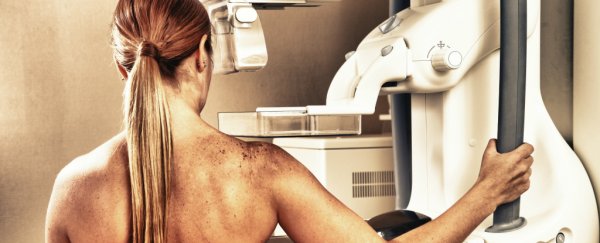Researchers have developed machine learning software that can accurately diagnose a patient's breast cancer risk 30 times faster than doctors, based on mammogram results and personal medical history.
The system could help doctors give better diagnoses the first time around - which means fewer mammogram callbacks and false positives.
"This software intelligently reviews millions of records in a short amount of time, enabling us to determine breast cancer risk more efficiently using a patient's mammogram," said one of the researchers, Stephen Wong, from Houston Methodist Research Institute. "This has the potential to decrease unnecessary biopsies."
A mammogram is a breast X-ray that aims to spot any potentially cancerous cells before symptoms arise.
In many countries, women over the age of 50 are advised to get a precautionary screening every two years, but as good as that system is, 50 percent of the tests in the US yield false positive results. In other words, one in two healthy women are wrongly being told they might have cancer.
On top of that, there's a big grey area of 'suspicious' mammograms, which fall anywhere between a 3 and 95 percent cancer risk, and these patients are recommended to have follow-up biopsies.
Right now, about 20 percent of biopsies in the US are unnecessarily performed, according to the researchers, and the new AI has been designed to greatly reduce that number by making a more accurate diagnosis the first time.
Computer software is already used to help doctors analyse mammogram images themselves, but this system takes things one step further, by looking at the doctors' reports on these scans, as well as a patient's full medical history, to more accurately determine breast cancer risk.
In the most recent demonstration, the researchers tested the AI on 500 breast cancer patients' mammogram results and pathology reports.
Within a few hours, the software had come back with diagnostic information - specifically, it identified the breast cancer subtype each patient had.
The researchers then double checked the AI diagnoses with clinical results, and showed that the software was 99 percent accurate. The same analysis would have taken doctors more than 500 hours.
"Accurate review of this many charts would be practically impossible without AI," said Wong.
To be clear, the AI so far hasn't been tested in a real-world setting - the results analysed in this study were from existing breast cancer patients - but the researchers have now provided enough evidence to warrant follow-up trials.
It also won't be able to prevent all false positives or suspicious mammogram results - sometimes there's just not enough information available to make a diagnosis. But it should help doctors make a more accurate conclusion.
We're looking forward to seeing how this software could make breast cancer diagnosis - as well as other cancers - faster and more accurate, and save people the time and stress of unnecessary further testing.
The results have been published in the journal Cancer.
